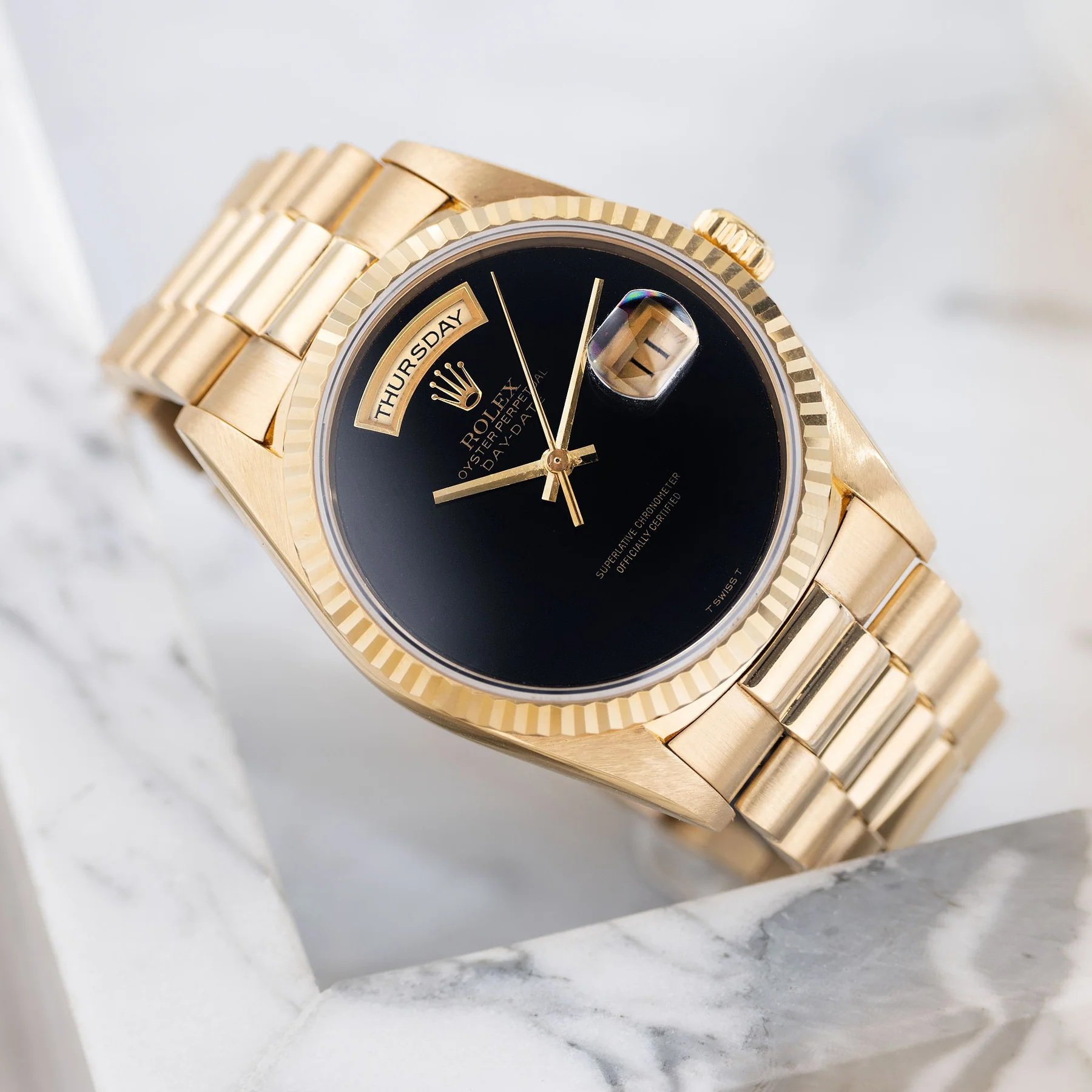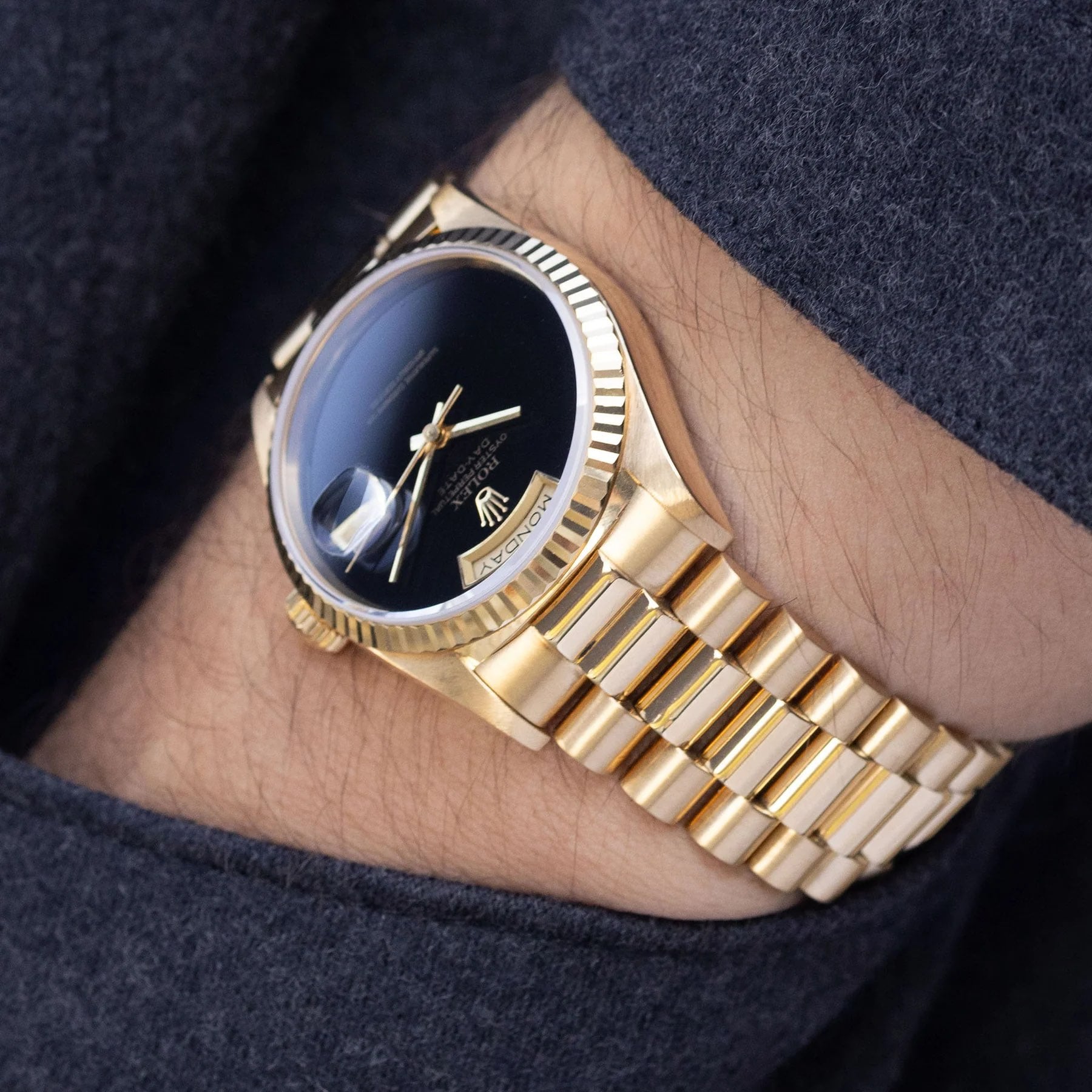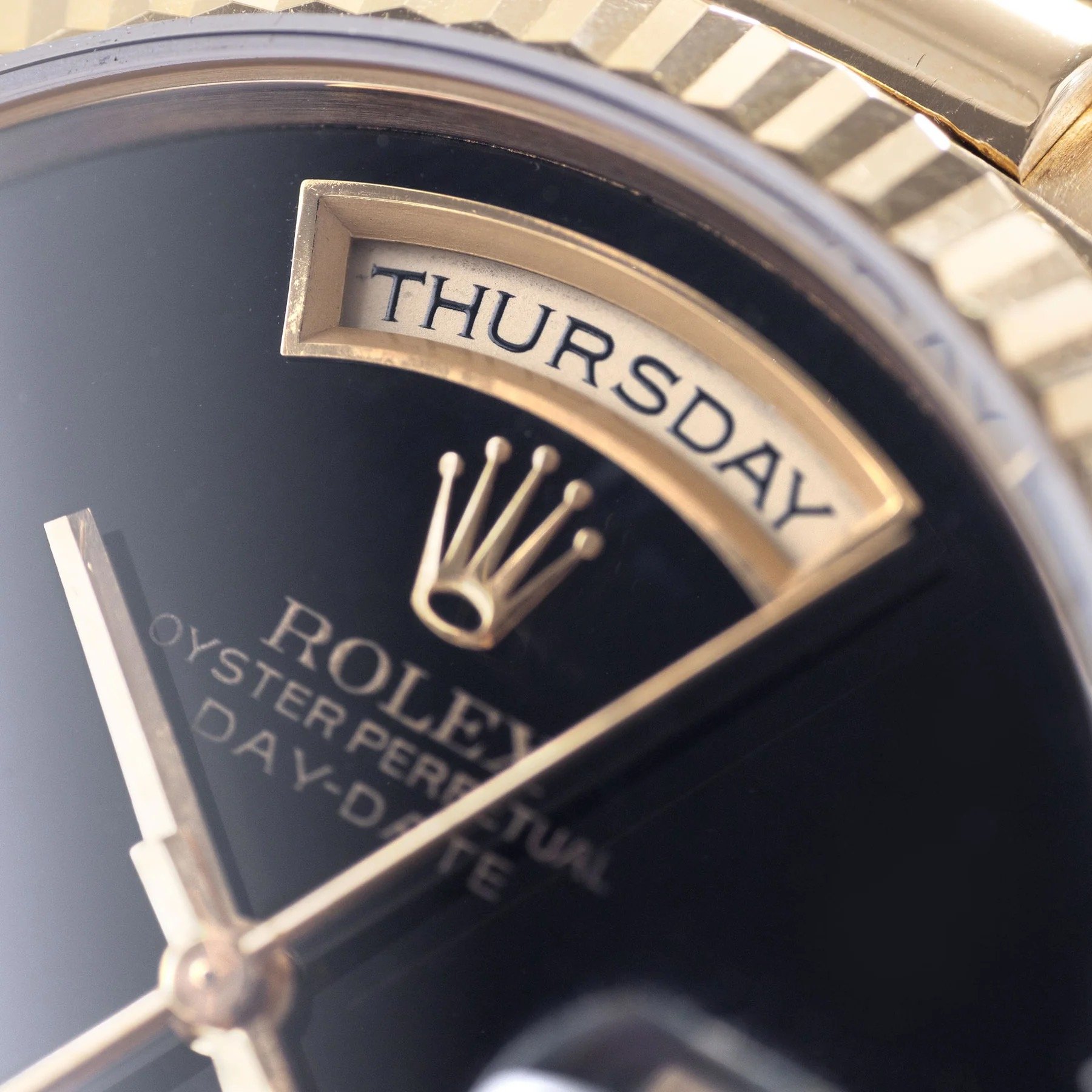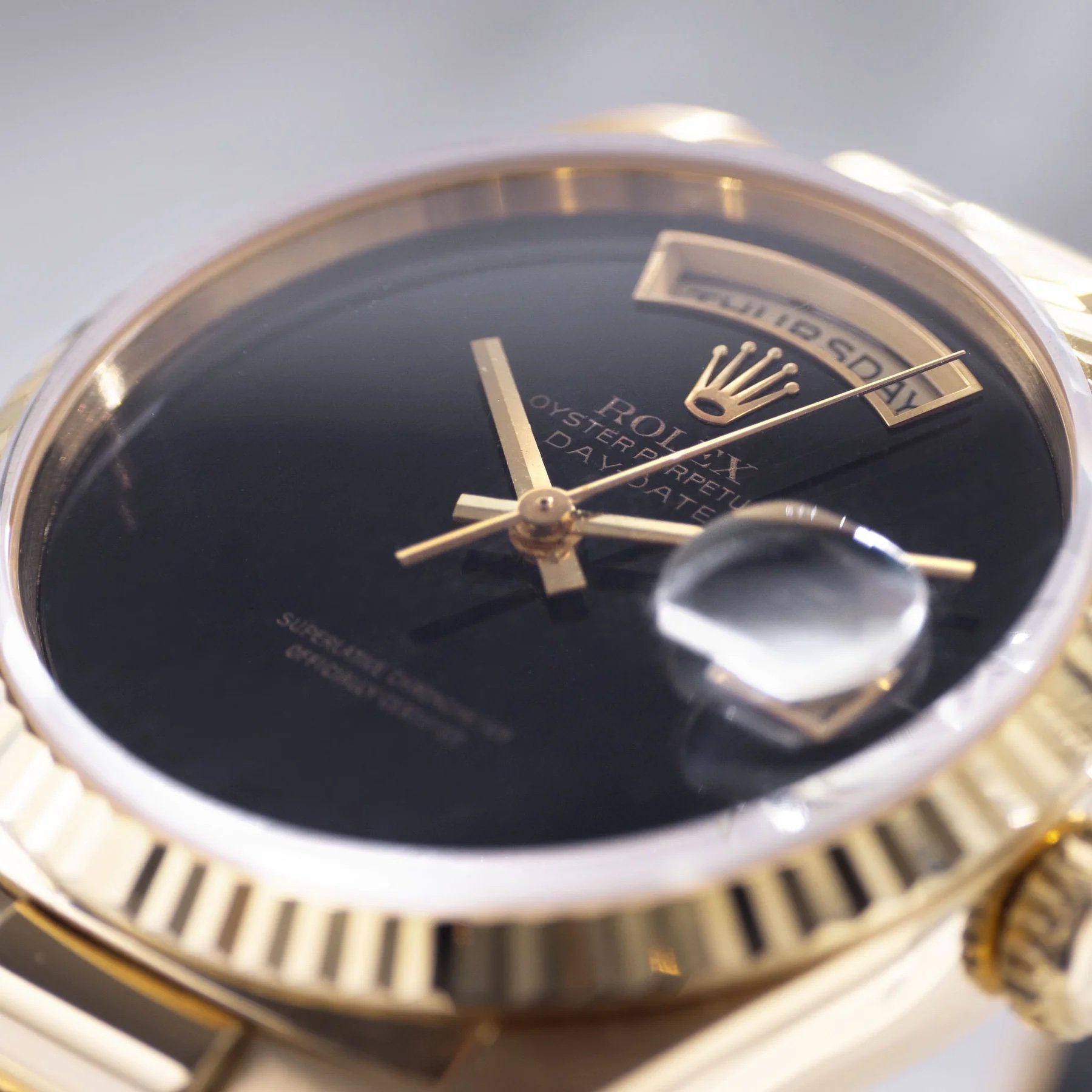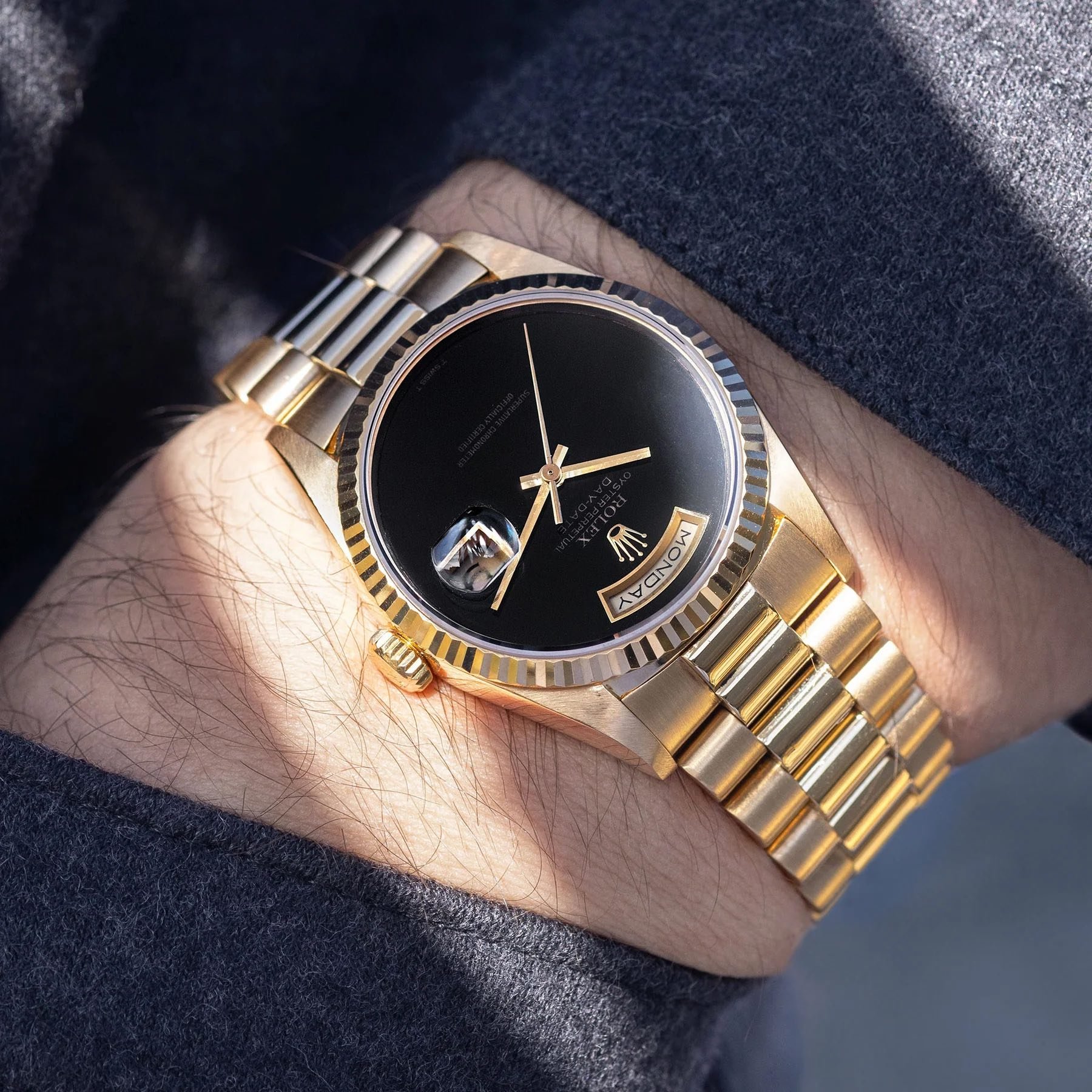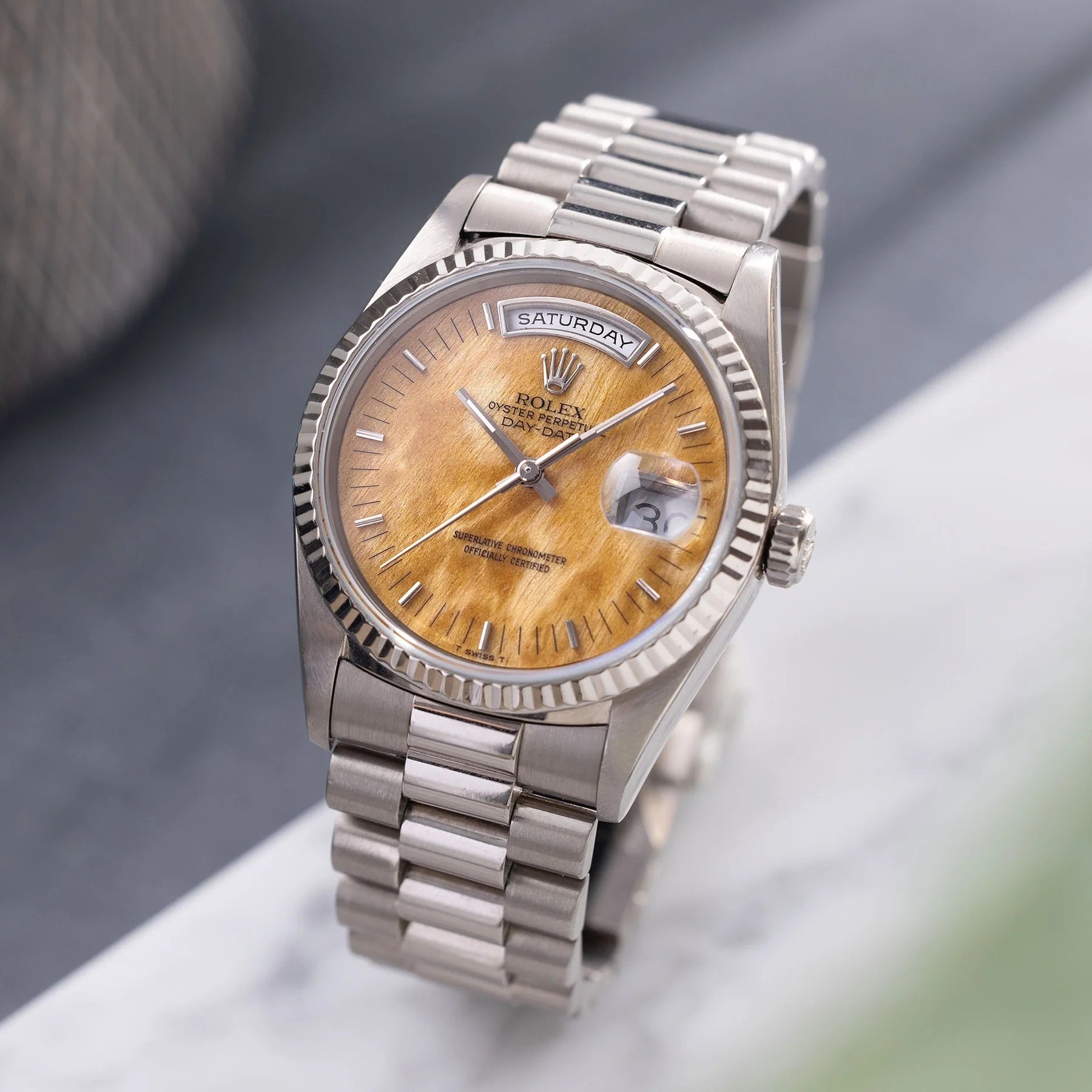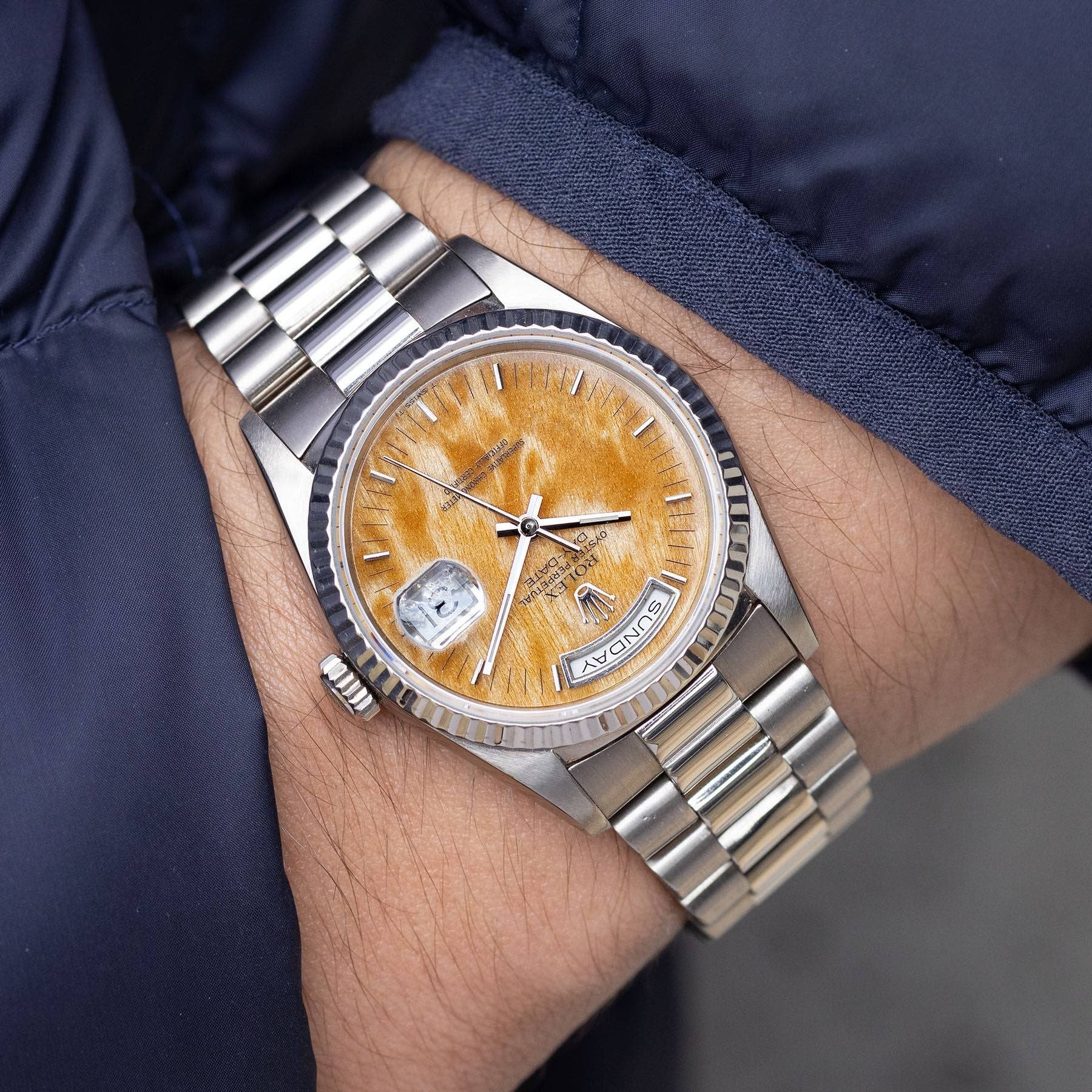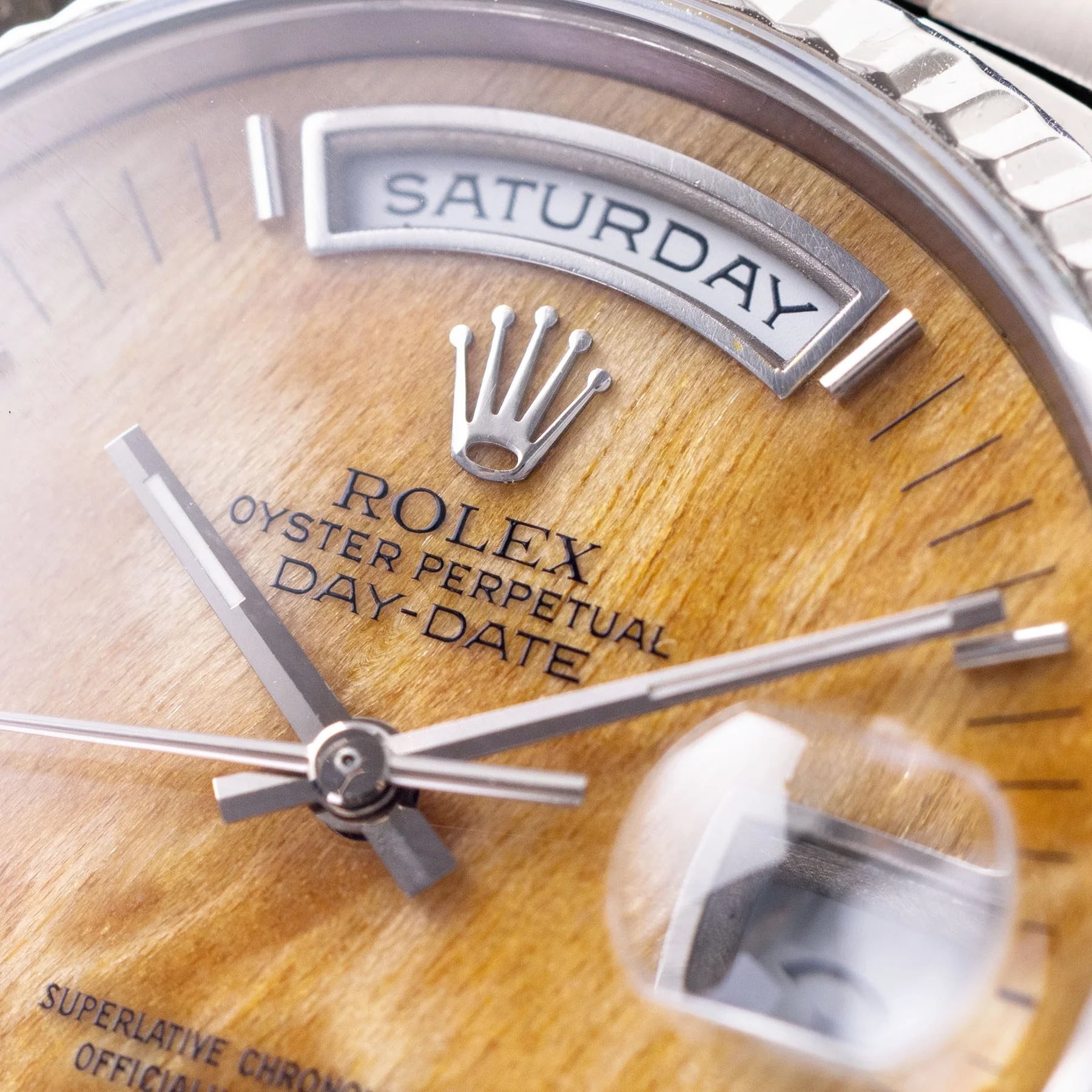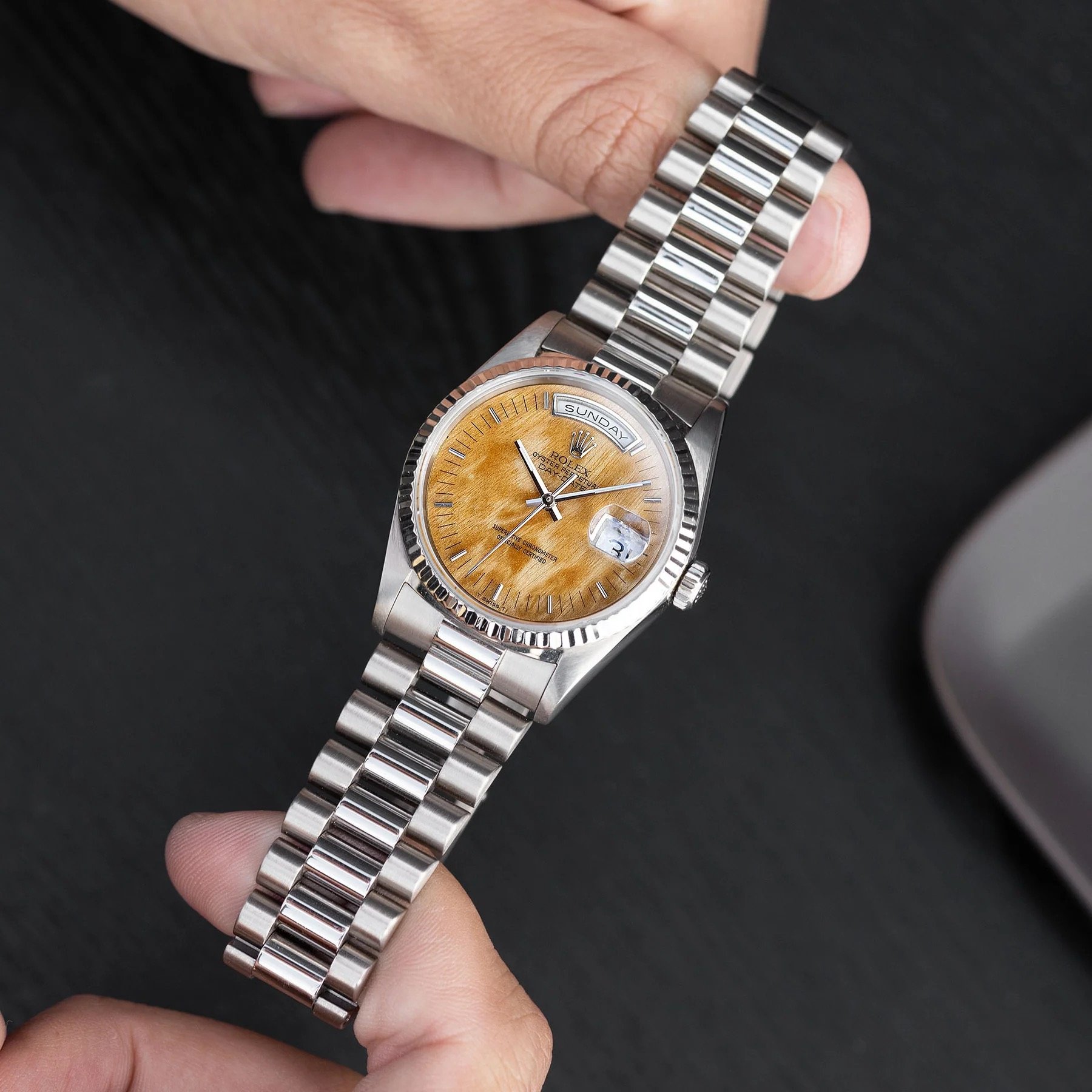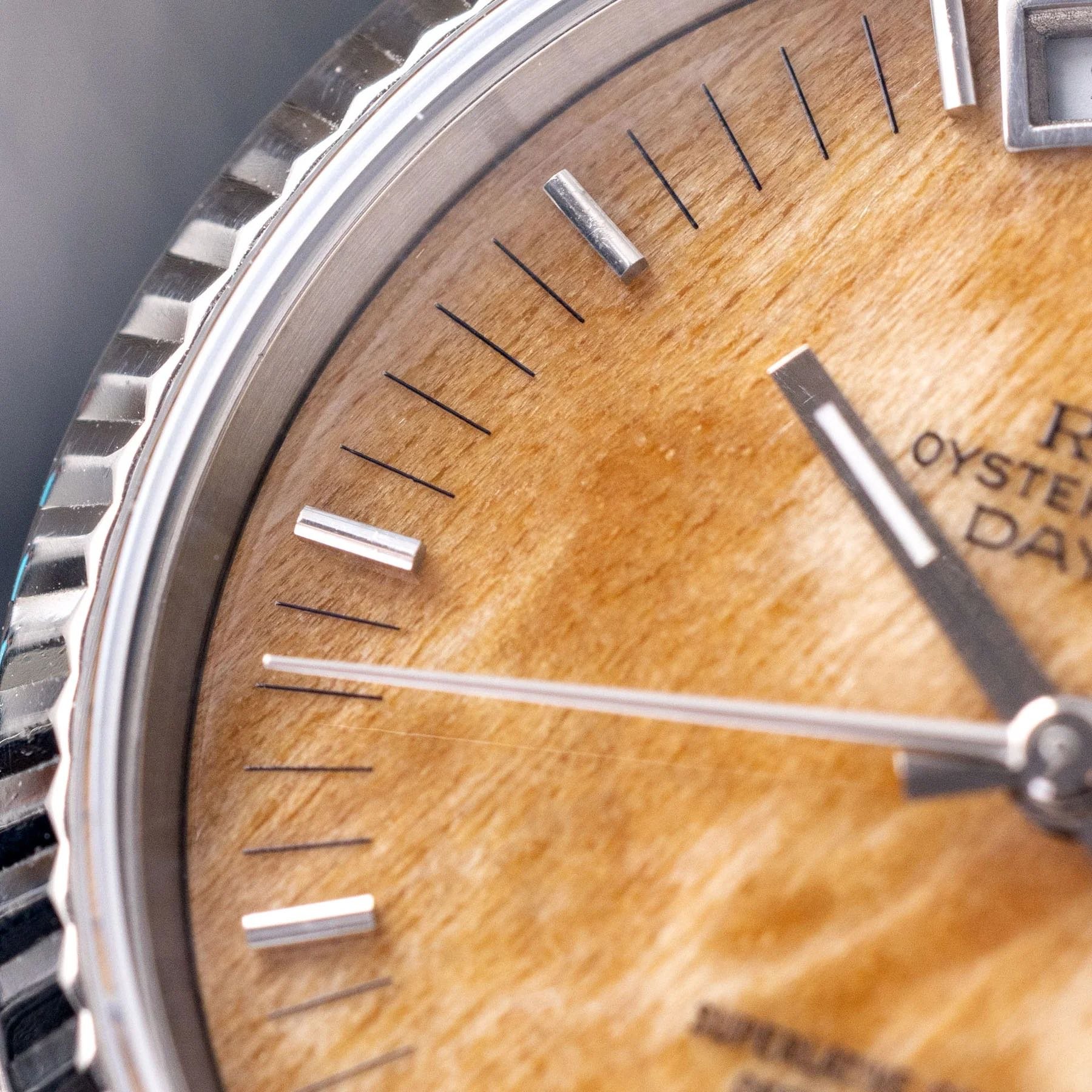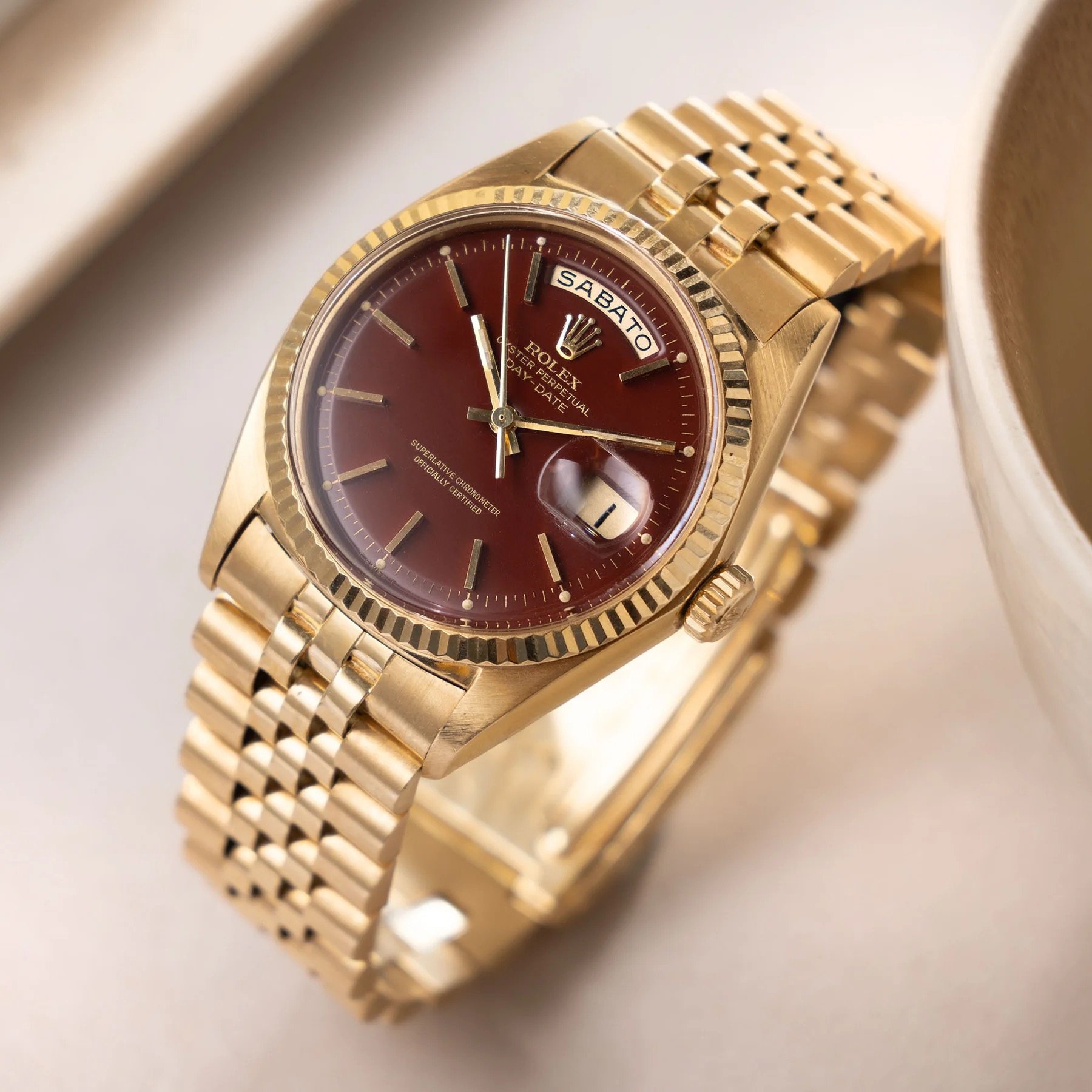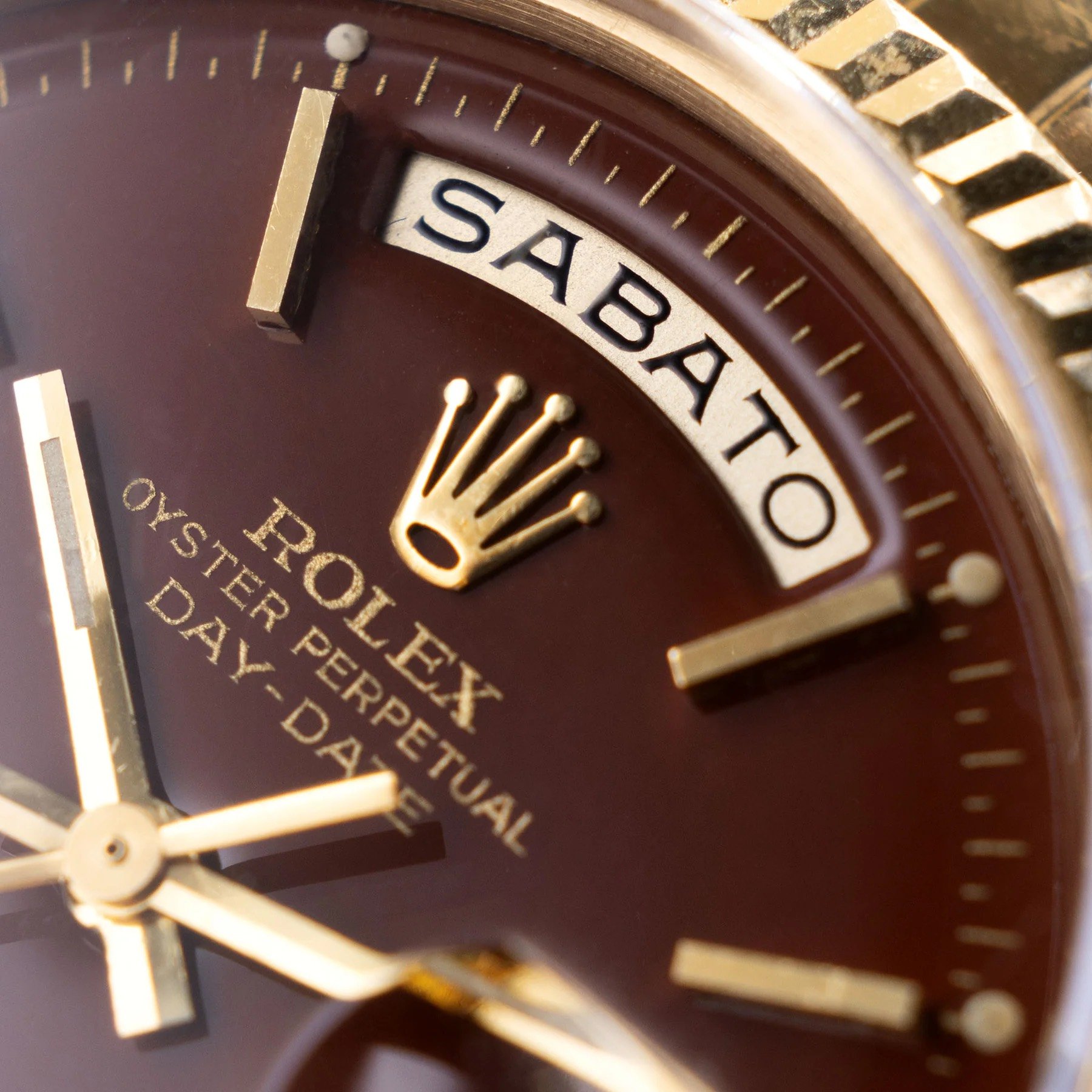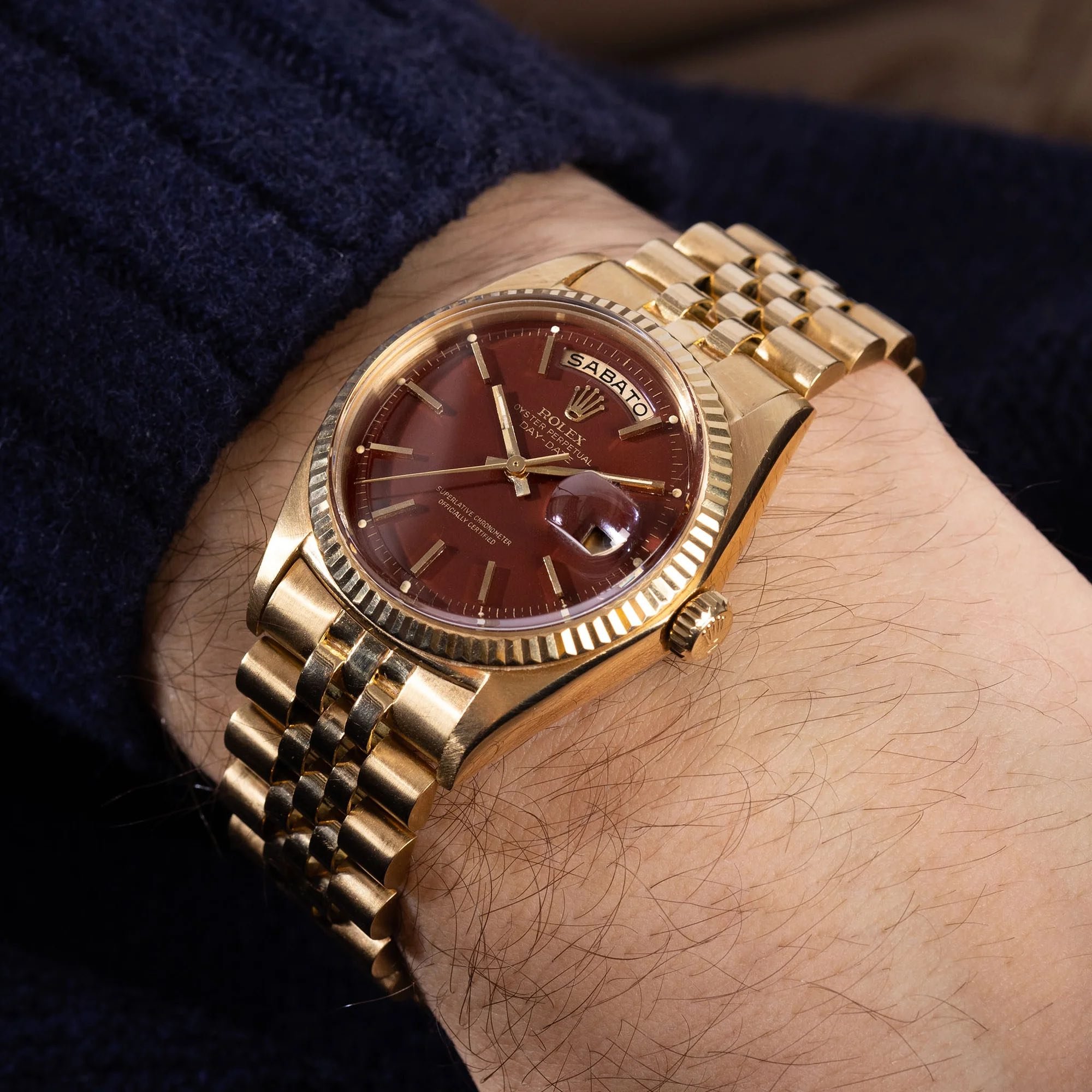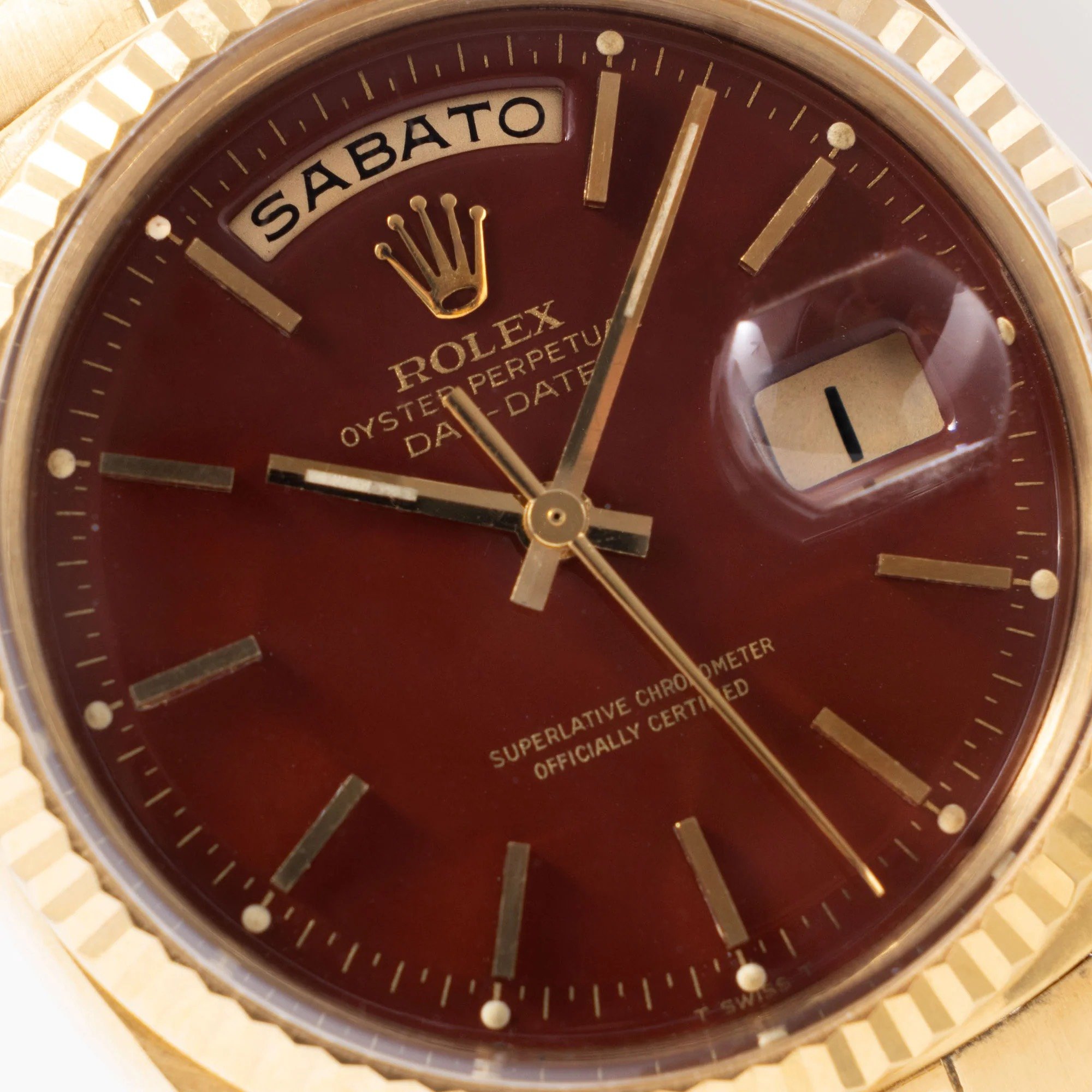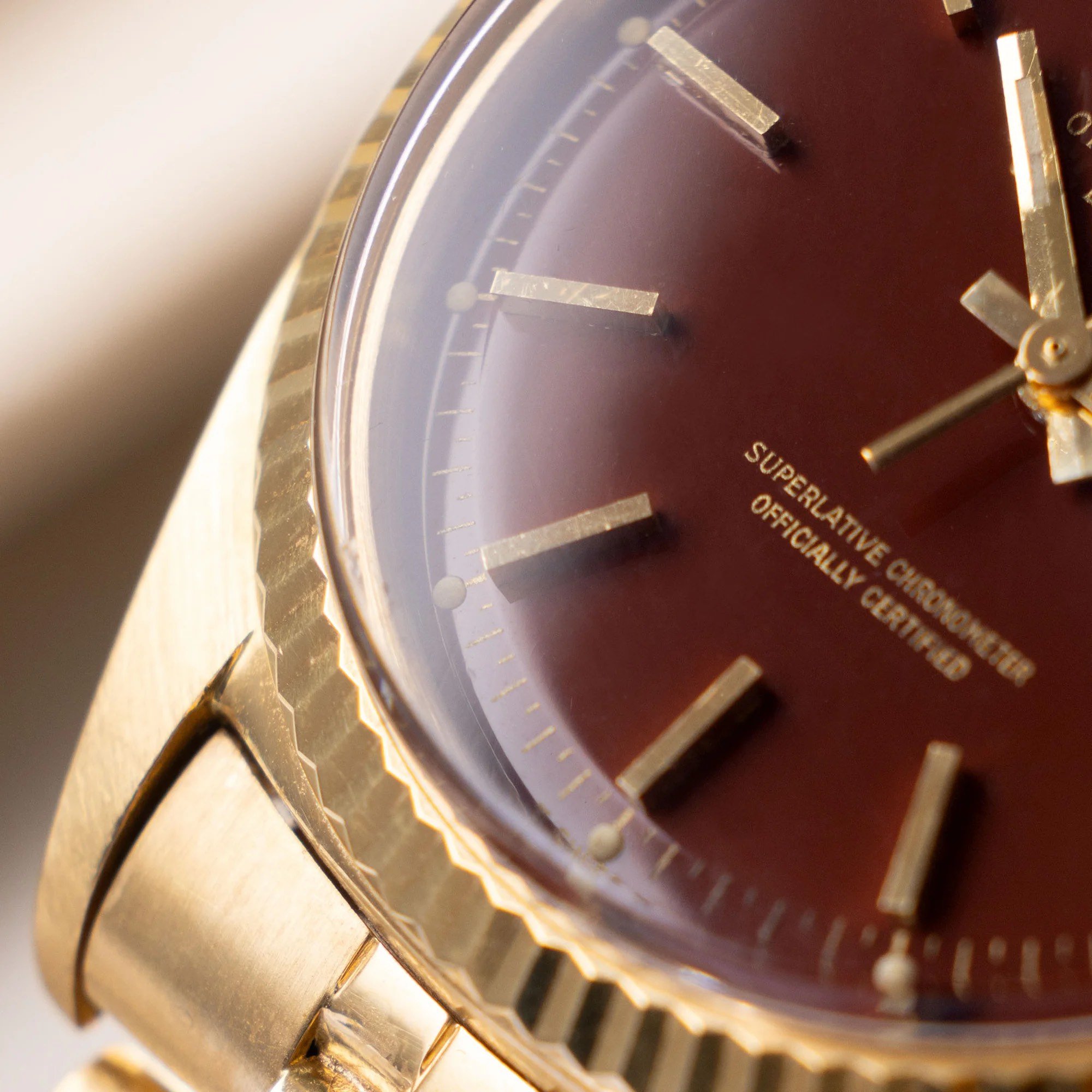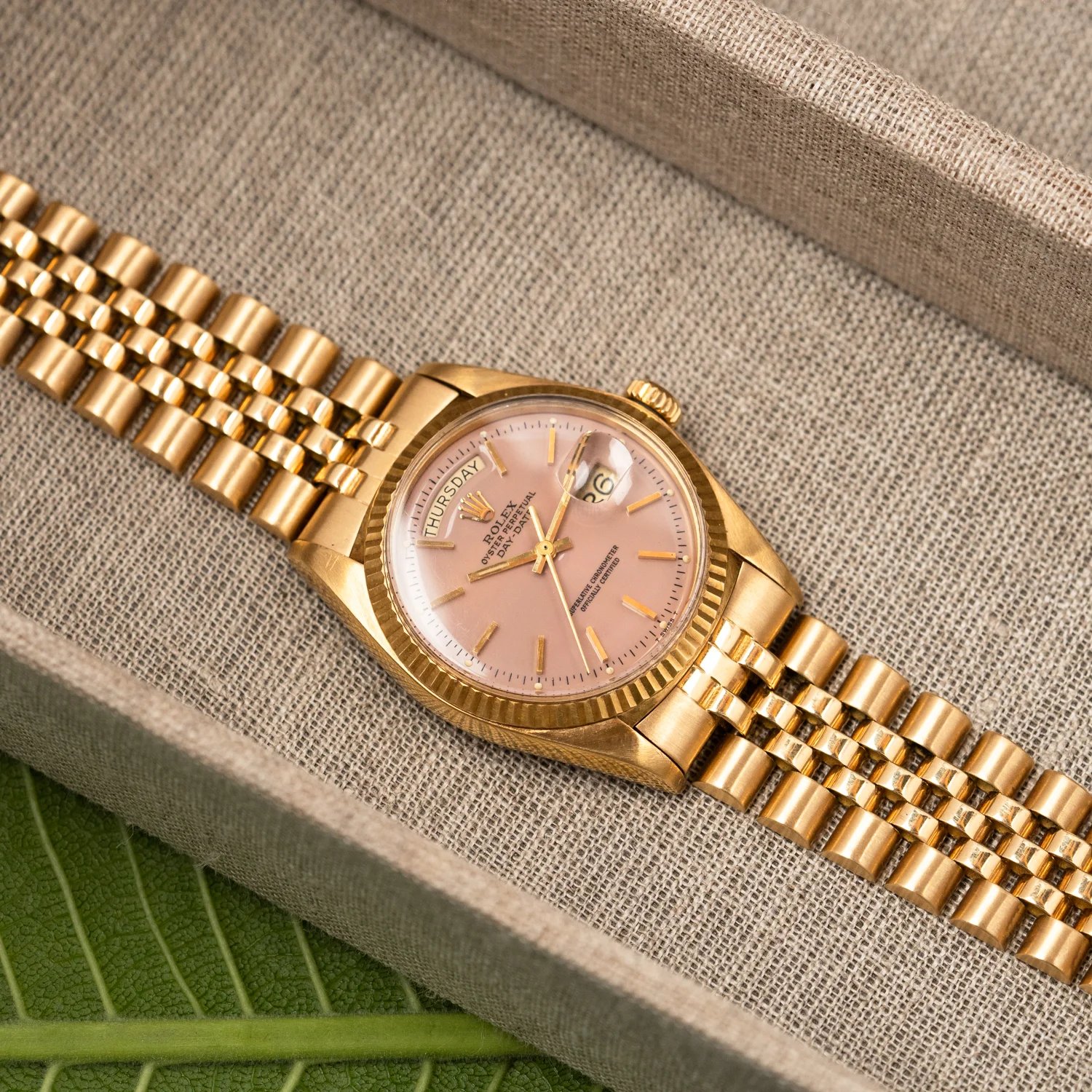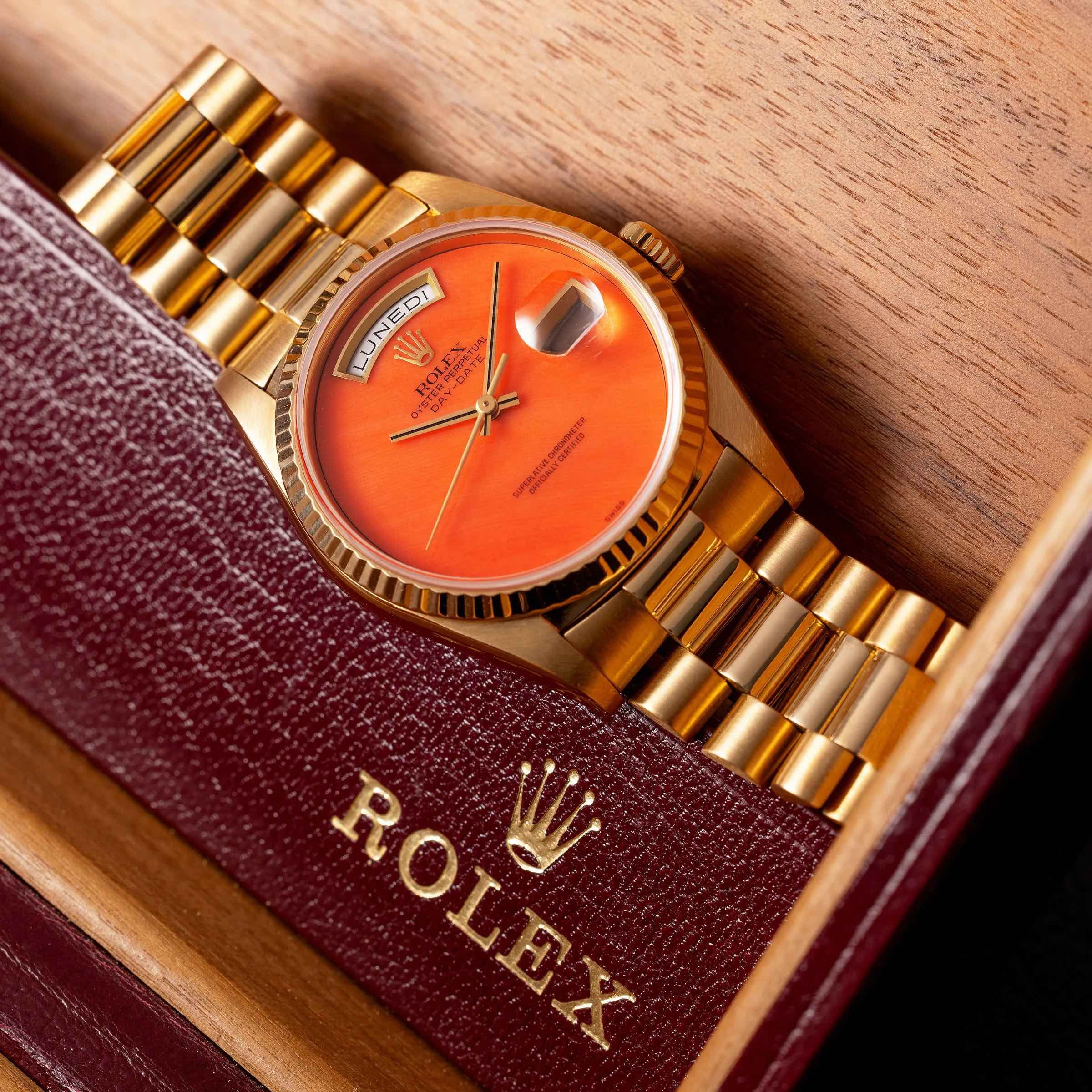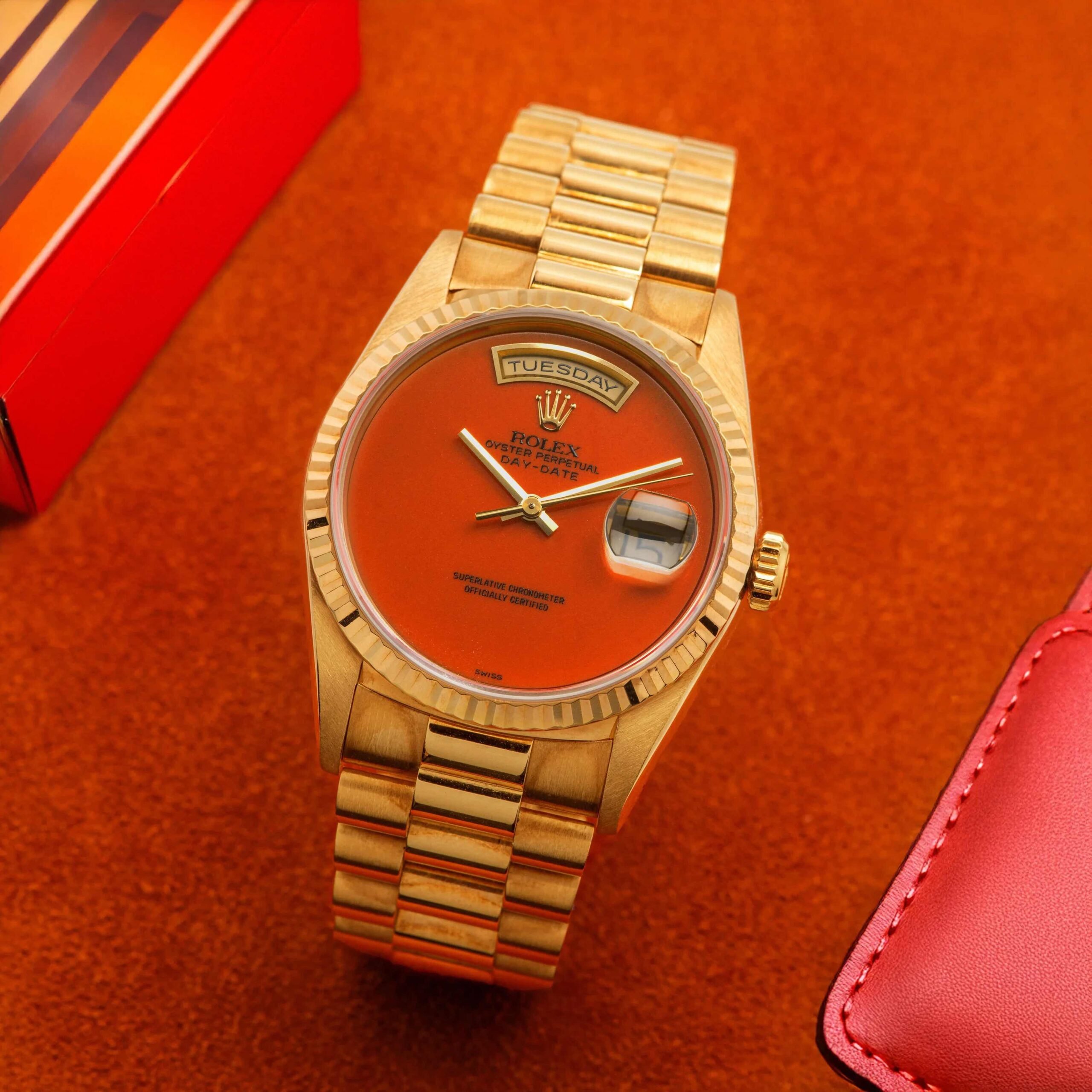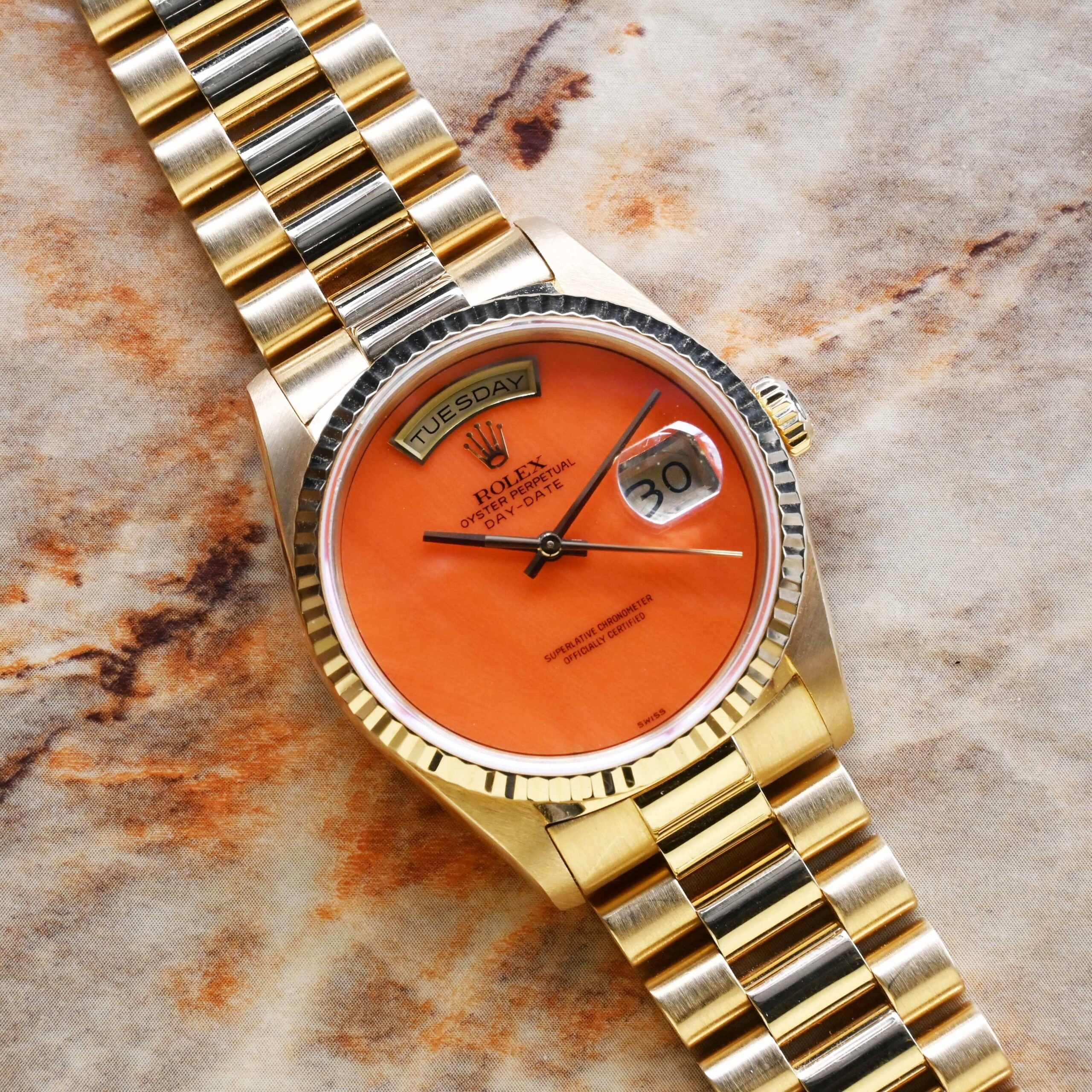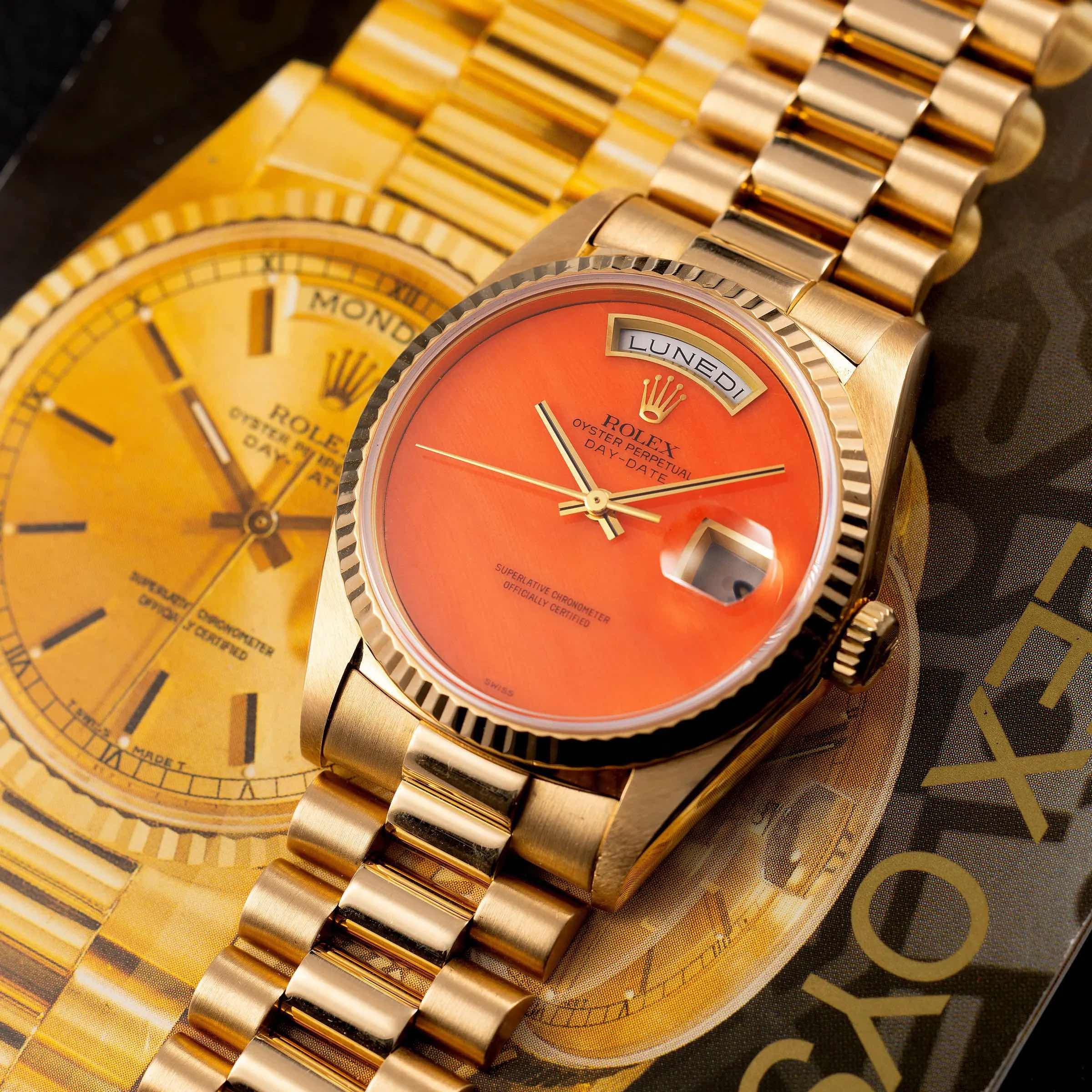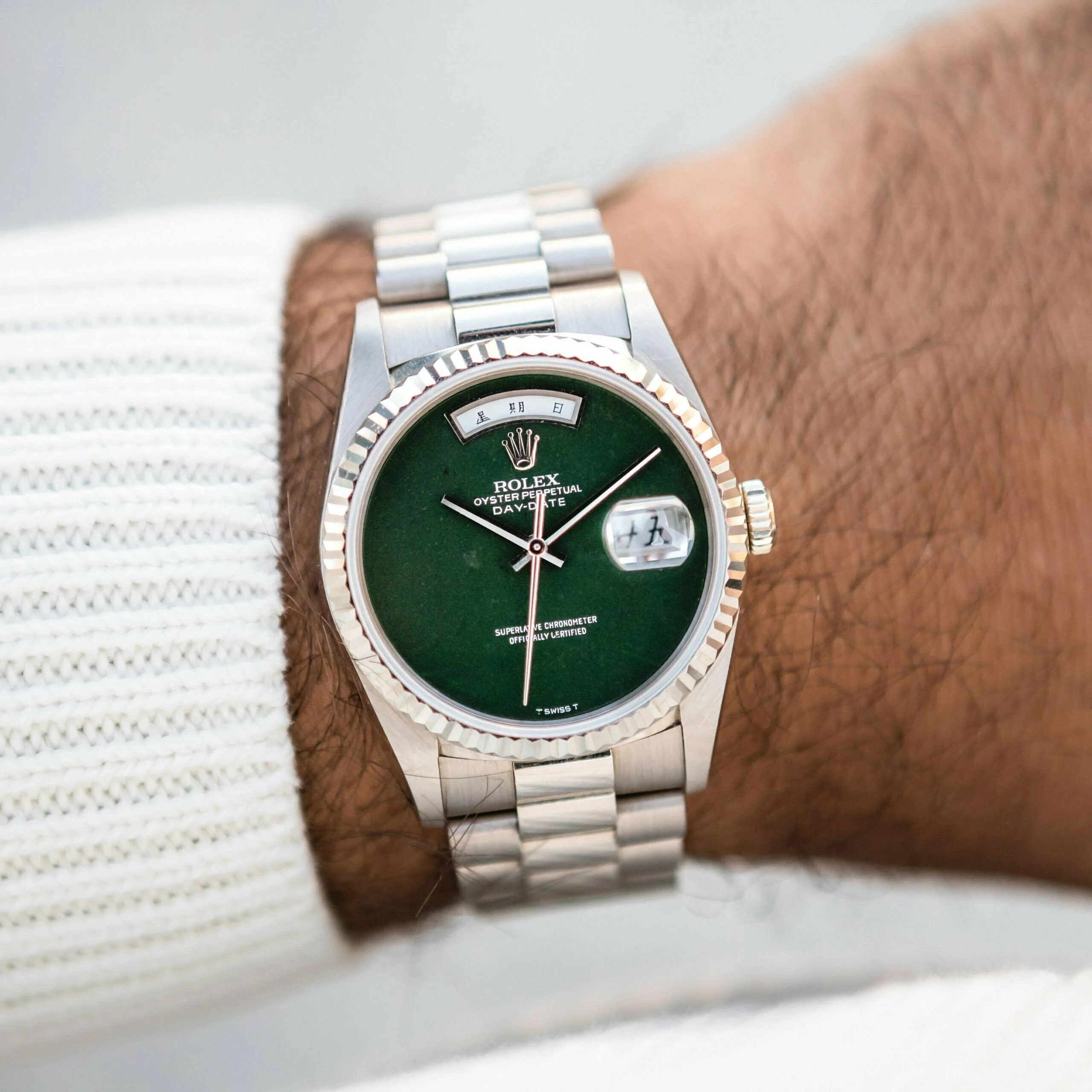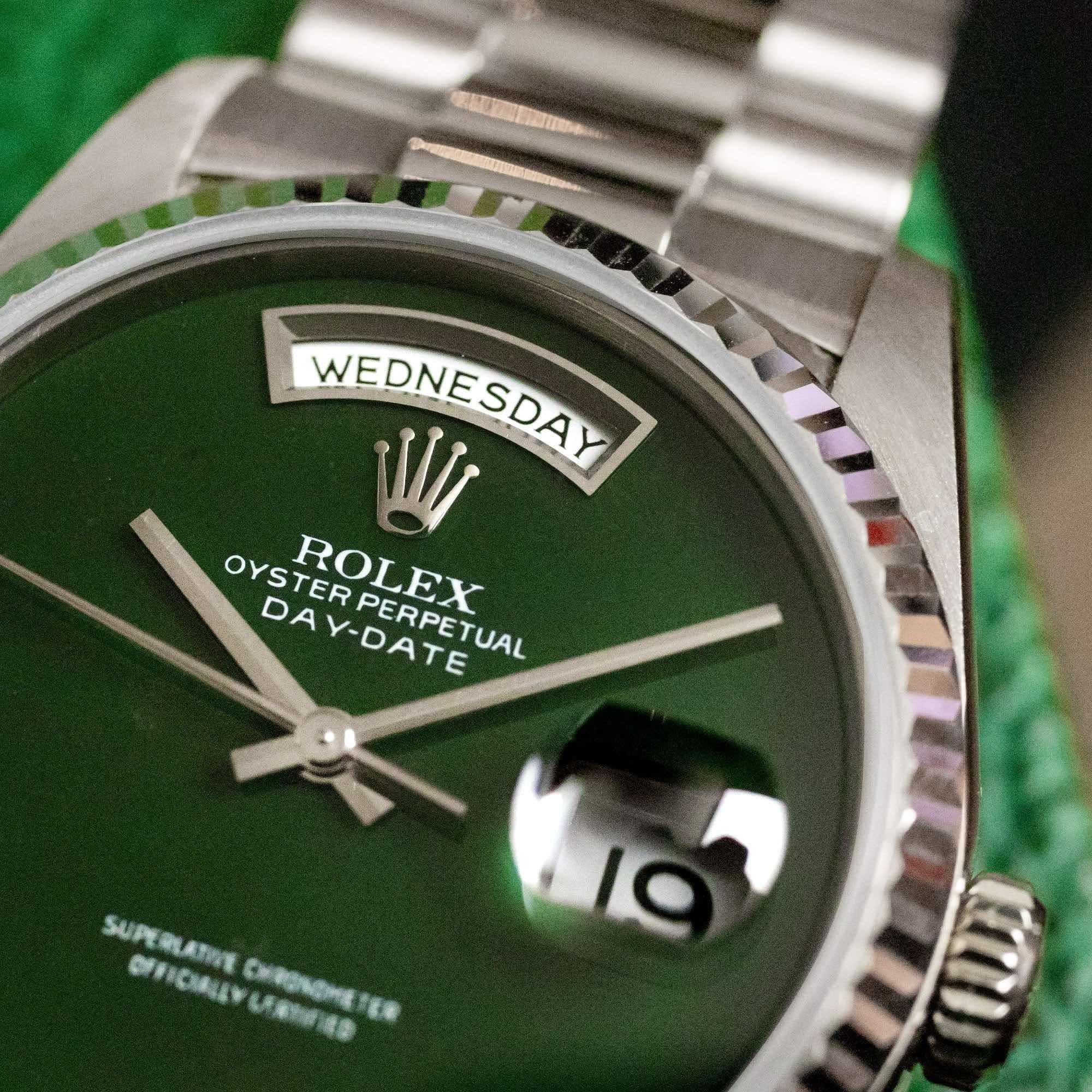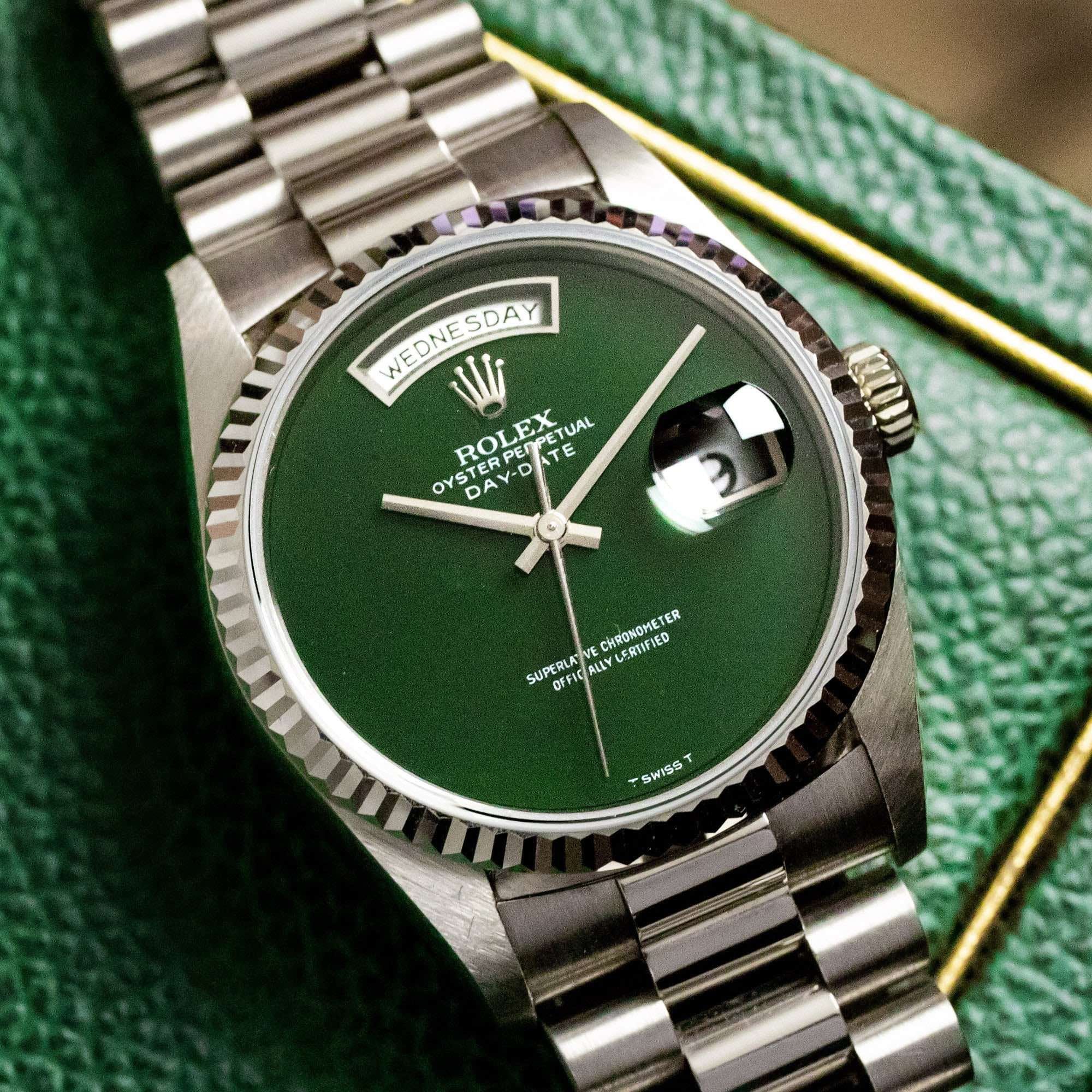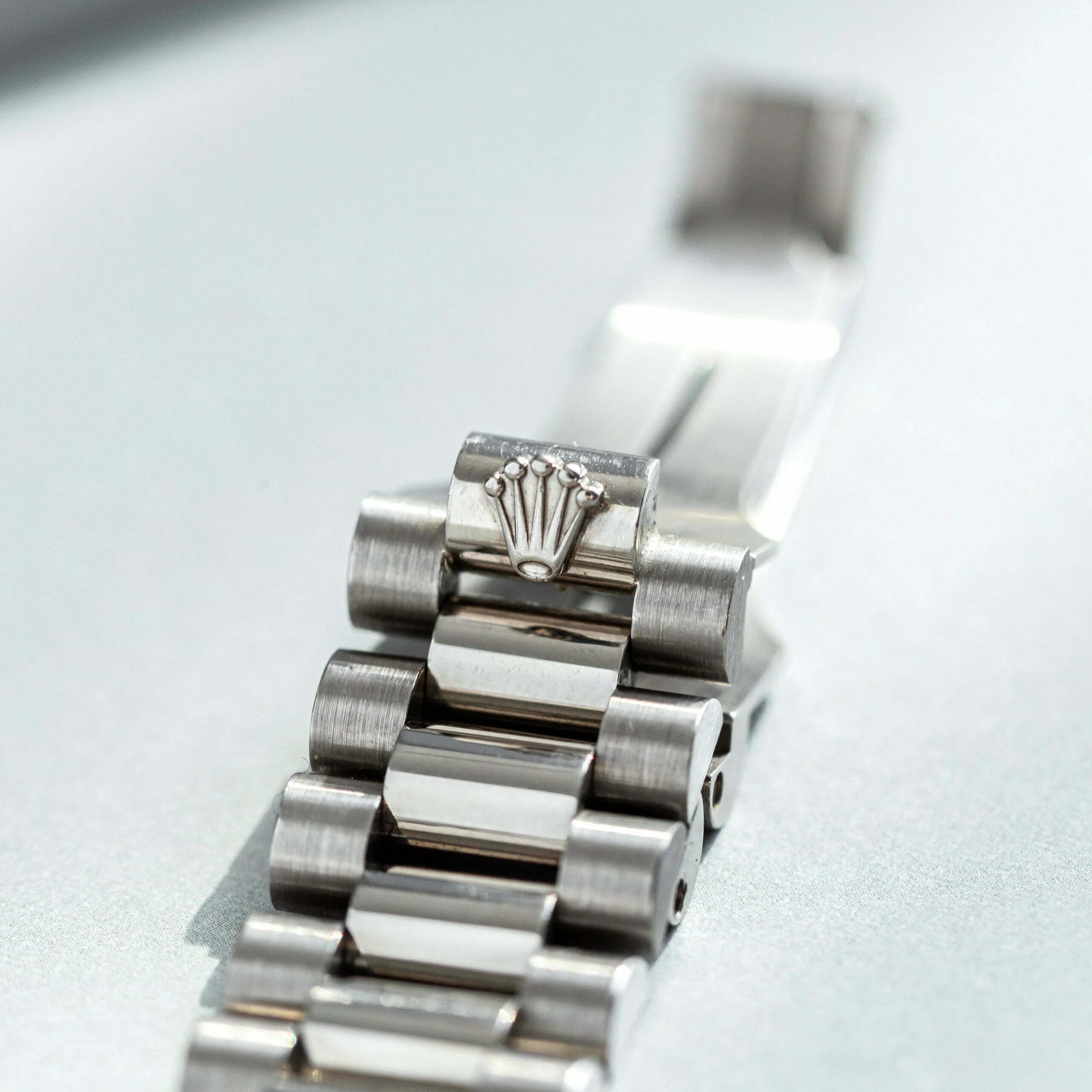Fratello’s Top 5 Rolex Day-Date Models With Exotic Dials
The Rolex Day-Date has long been the brand’s flagship model. We sometimes forget that fact due to all the new Rolex releases every year. We usually only see new dial variations for the Day-Date. But that makes sense; after all, why drastically change something if it’s already so good? This is why we decided to focus on Day-Date dials for this week’s list. Specifically, we selected five Rolex Day-Date models that stand out immediately because of their exotic dials and show the great variety of this Rolex classic.
Before getting into the list, we should note that several dial styles/materials were available with different references. So whenever we mention a reference, it is not necessarily exclusive to that dial. This article is less about the references or the sometimes astronomical prices these watches command. Instead, it’s more about appreciating the great diversity these dials bring to the Rolex Day-Date portfolio.
Rolex Day-Date ref. 18238 with an onyx dial
Our first pick is one of those dials that was an option for multiple generations of the Day-Date. The one we picked is the Rolex Day-Date ref. 18238 in yellow gold with a black onyx dial.
Rolex produced this reference between 1988 and 2000. The watch marks a big change from previous Day-Dates because the new caliber 3155 has a double-quickset feature. This allows owners to adjust the weekday and date indicators easily. As a result, this is one of the best vintage/neo-vintage yellow gold Day-Dates to look for if you are in the market. It offers the great classic looks of the Rolex Day-Date with modern-day practicality.
The onyx-dial version of the yellow gold Day-Date is one of the much-desired configurations that fans love. There is something magical about the combination of yellow gold and the deep black hue of the onyx dial. This dial famously has no hour or minute markers. However, it still features the applied gold Rolex coronet and several lines of gold text on the top and bottom halves of the dial.
Additionally, the dial shows a day aperture at 12 with a yellow gold frame. The day disc is white with black printing and matches the date window, which has a similar configuration with a gold frame, white disc, and black printing.
The three yellow gold hands hover over the deep black dial, finishing the stylish look. This onyx-dial ref. 18238 is truly one of the nicest Rolex Day-Date models out there, and it can be yours for €35K–50K.
Rolex Day-Date ref. 18239 with a birchwood dial
We are staying with the same generation of the Rolex Day-Date for our next pick, but the case/bracelet material is different. This time, it’s the Day-Date ref. 18239 in white gold. I chose this version because the material used for the case and bracelet contrasts nicely with the birchwood dial. It’s a spectacular combination that makes this watch one of the most visually striking Day-Date models out there.
As most of you will know, this birchwood dial was part of a wider series of wooden dials that the Genevan brand produced. On top of that, the wooden dials were not limited to the Day-Date. Rolex also used them for its Cellini line of watches.
Originally, the wooden dials were a product of the ’70s, and they came in different variants over the years. Rolex produced sequoia, birchwood, mahogany, and walnut variations, each with a different aesthetic. Some of the Day-Date references with wooden dials have a bark finish on the bezel and bracelet center links to further enhance the tree-like feel of these models.
While that is an acquired taste, you can’t argue with the visual brilliance of this white gold ref. 18239 with its birchwood dial. This combination of materials is not limited to this generation, though, as the previous ref. 18039 came in the same configuration.
Current prices for a white gold Rolex Day-Date ref. 18239 with a birchwood dial range between €40K and €60K. If that is not your style or you want something slightly more “affordable,” the yellow gold version with a birchwood dial goes for around €25K €35K.
Rolex Day-Date ref. 1803 with an oxblood Stella dial
On to a proper vintage classic. The Rolex Day-Date ref. 1803 was part of the 1800 series, which debuted in 1959 as the successor of the ref. 66xx models. With the 1800 series, the Day-Date took on the aesthetic that has remained to this day. Rolex changed the style of the hands and hour markers and slightly updated the case shape. The result was a Day-Date that still looks like the current models.
The 1803 featured a 36mm case in white gold, yellow gold, rose gold, or platinum. The watch retained a pie-pan dial, but it was updated with baton indexes to match the new baton hands, which replaced the famous alpha hands. What remained was the namesake combination of day and date indicators, along with a Cyclops magnifier for the latter.
Rolex first equipped the 1800 series with the new caliber 1555. Then, in 1965, Rolex updated it to caliber 1565, which increased the beat rate from 18,000vph to 19,600vph. In 1972, the brand added a hacking seconds function to the caliber that powered the ref. 1803 until the 18000 series replaced it in 1978.
The famous Stella dials
There are plenty of dials to choose from for this generation of the Day-Date. Famous among Rolex fans are the colorful Stella lacquer dials, which come in various colors. We picked the oxblood variant, which makes for a classy combination with the yellow gold case and bracelet.
Just look at how well that red color has aged. It immediately adds an unmistakably classy vintage air to the watch, giving it a more serious look than the bright colors we usually associate with Stella dials. That makes it stand out, but does it make it better? Well, not necessarily because the Stella dials are all about personal preferences.
My favorite is the ultra-rare lilac Stella dial, which is high on the wish lists of Rolex collectors with super deep pockets. For the oxblood version, with prices hovering around €50K, you just need “regular” deep pockets.
Rolex Day-Date ref. 18238 with a coral dial
The famous coral-dial version of the Rolex Day-Date is probably my all-time favorite exotic version of Rolex’s flagship model. The bright orange coral dials were used for several generations of the Day-Date. As you will understand, the reference to go for with a coral dial is the 18238 because it offers modern-day practicality along with a spectacular dial.
Like the onyx dial I featured earlier, this orange coral dial doesn’t feature any hour markers or a minute track. This keeps the dial relatively clean and allows you to properly admire the natural coral material. There are versions in a similar color labeled “coral red” that feature markers and a minute track, but they are not the same. Those are lacquered Stella dials rather than natural stone.
The attraction of the orange coral dial
What makes the coral dial so special? For me, it’s all about coral’s distinct presence. It’s not a bright, in-your-face type of orange. Although the color is vivid, a veiny structure is accompanied by a soft, hazy feel that I adore. On top of that, there aren’t many watches that can make an orange dial like this look good. That’s a big part of the magic of the Day-Date for me. It is the perfect canvas for Rolex to experiment and introduce different dial colors and materials.
The coral dials feature black printing. I like the contrast with the orange dial, and the text matches the text color on the day and date discs. Expect steep prices for a Day-Date with a coral dial, regardless of the reference, as values have risen dramatically. Only a few years back, you could see prices around €70K–75K. Nowadays, a coral-dial Day-Date can easily fetch up to €200K.
Rolex Day-Date ref. 18239 with a jasper dial
Let’s close this list out with another white gold Day-Date ref. 18239. It is the perfect canvas for the deep green jasper stone dial. The combination of white gold and the rich green color turns out to be stunning and crisp. It makes it another favorite in this short list of great options. But it’s not one you’ll come by easily because these jasper dials are very rare. Finding one without hairlines or cracks is almost impossible.
As some of you might know, jasper comes in different colors. The natural stone can be red, yellow, brown, or green. Rolex picked the last option as the color for its jasper dials. What makes these dials so special is that they have little intricacies that make them come alive. Some have red speckles, which create a completely different look. I like the fully green jasper dials the best, though, as they represent Rolex’s signature green color to an extent.
Additionally, the beautiful shade makes me think of Wimbledon’s green. As a player and a fan of tennis, that is a special connection. On top of that, this white gold Day-Date is an understated statement of pure class. Only Rolex fans will understand what makes this Day-Date so special, and it’s not just the deceivingly modest white gold case and bracelet. That is only the canvas for the true star of the show, the priceless and stunning jasper dial.
Final thoughts on our favorite Rolex Day-Dates with exotic dials
There you have it — our list of our top five Rolex Day-Date models with special dials. Of course, we left out some great options, like the popular tiger eye, malachite, and marble dials. But there is only room for five watches, so we had to make some hard choices. Let these five be the inspiration to share your favorite Day-Date models with exotic dials in the comments section. We will see you next week for another list!

